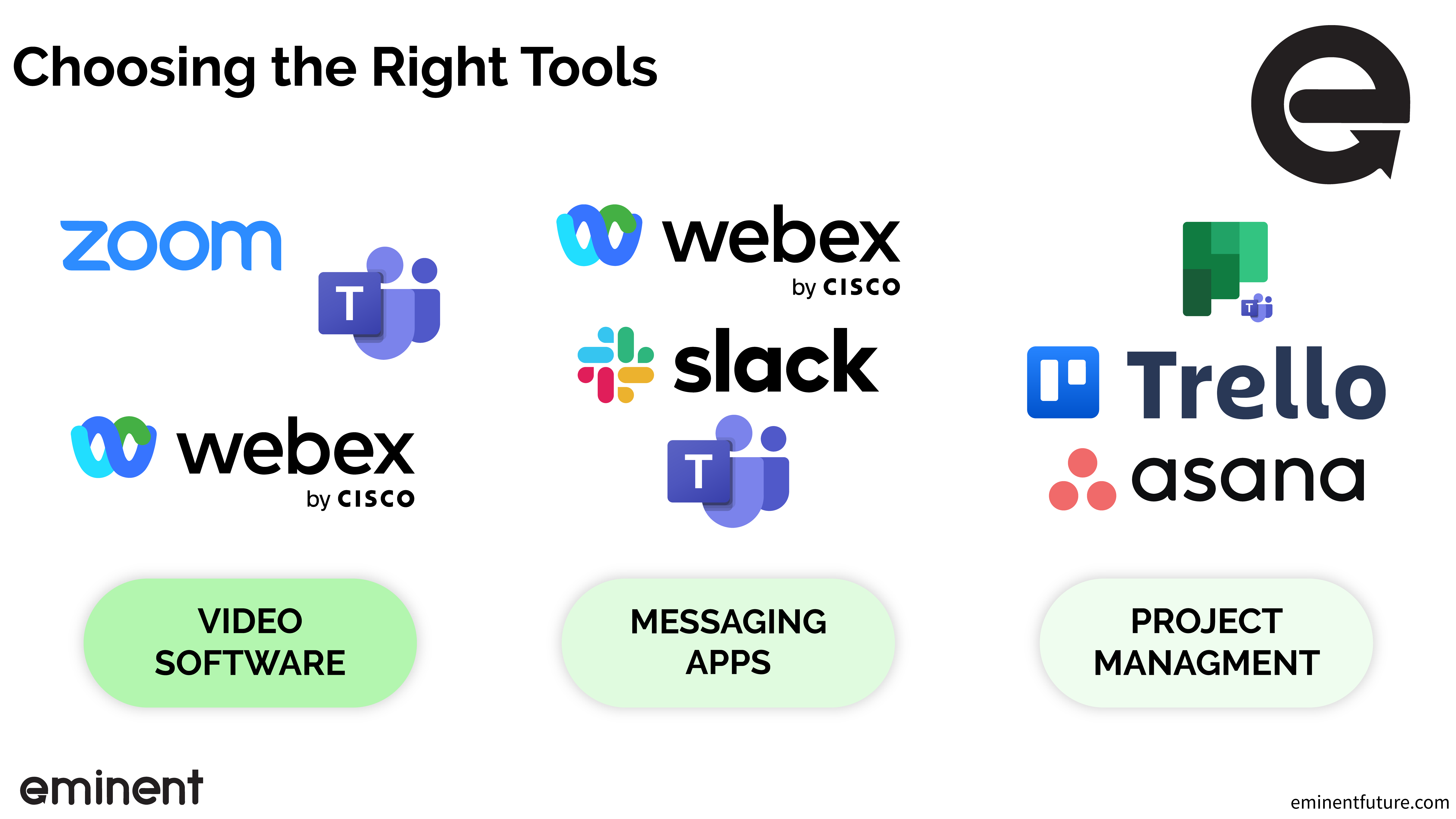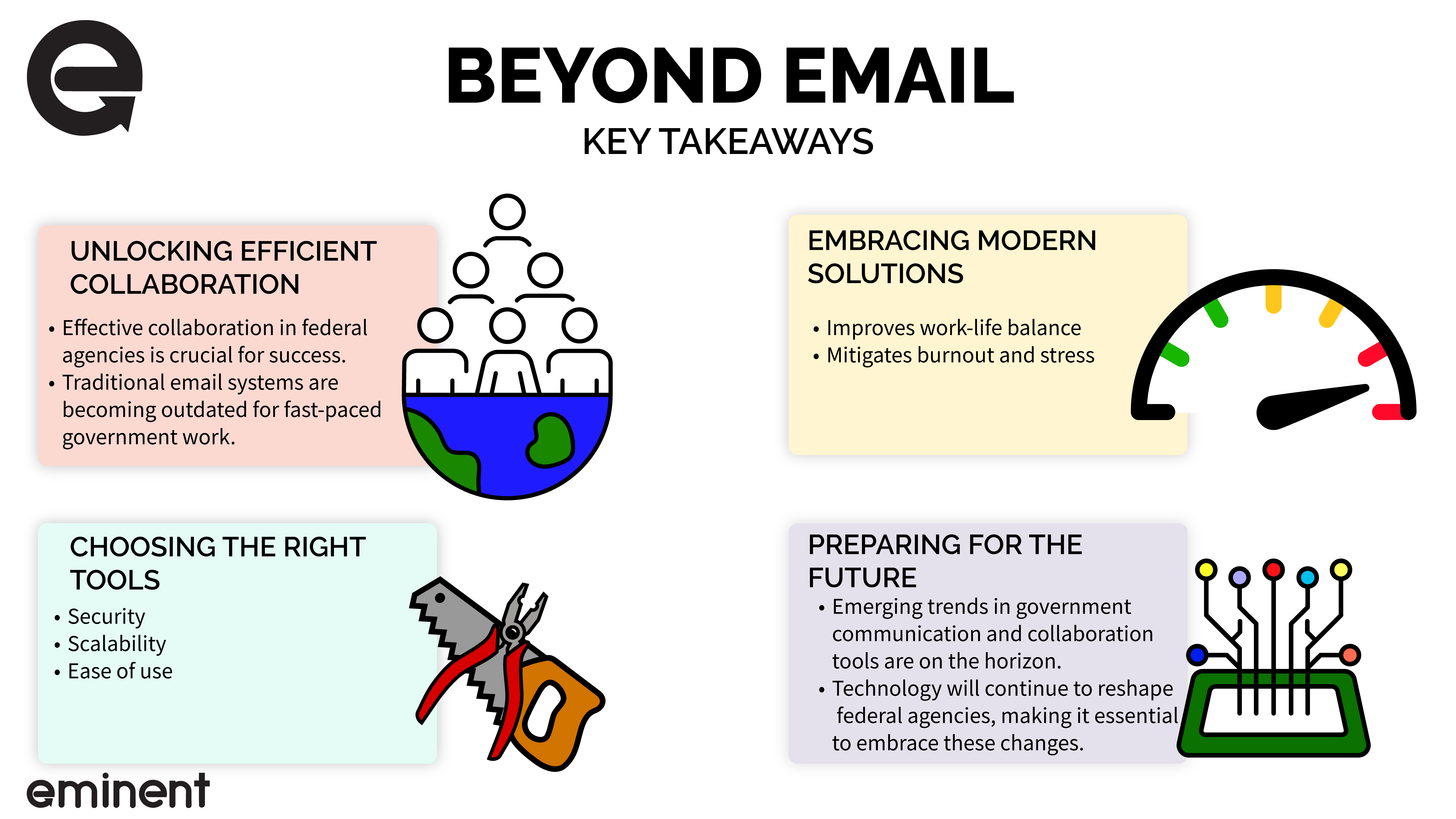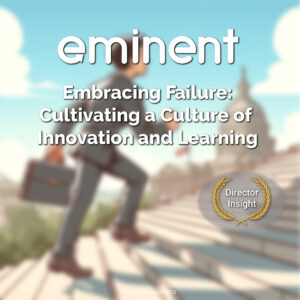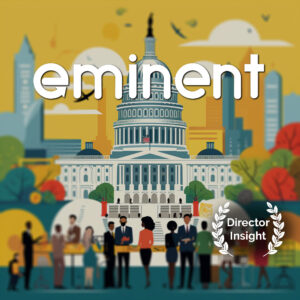
Traditional email has long been the bedrock of professional communication. However, the fast-paced world of federal agencies presents challenges: cluttered inboxes, delayed responses, and lost information. Efficient collaboration is vital for government work, and that’s where alternative communication tools come in.
In this blog, we’ll step beyond email to explore innovative tools that transform how federal directors and teams work together. From project management software to real-time team messaging apps and distance-bridging video conferencing tools, these alternatives reshape communication, boost efficiency, and elevate government missions. Join us as we discover the tools propelling federal agencies into a more efficient, collaborative future.
The Limitations of Traditional Email
In today’s dynamic federal agencies, the constraints of traditional email communication have become increasingly evident. While email has its merits, it has significant drawbacks.

Email's Drawbacks within Federal Agencies
- Inbox Overload: The constant influx of emails can lead to inbox overload. Federal directors and teams often struggle to sift through the sea of messages, sometimes causing critical information to be buried and missed.
- Delayed Responses: Waiting for email replies can hinder real-time decision-making. Time-sensitive matters may languish in a recipient’s inbox, potentially impeding the swift resolution of issues.
- Fragmented Conversations: When discussions span multiple threads or include several participants, it’s easy for conversations to become fragmented, leading to miscommunication and misunderstandings.
The Need for Modern Communication Methods
Efficient collaboration is the backbone of effective governance. Federal agencies require modern communication tools that can adapt to the demands of contemporary work. As we delve into alternative communication methods in this blog, we’ll uncover the solutions that address these limitations and elevate the quality of collaboration within government work.
Exploring Innovative Communication Tools
This section will delve into cutting-edge communication tools that transcend traditional email in federal agencies. These tools have demonstrated their potential to revolutionize collaboration, making government work more efficient and productive.

Beyond Email: A Diverse Toolkit
Let’s break free from the constraints of email and discover a range of dynamic alternatives designed to streamline communication in federal agencies. We’ll explore three notable categories:
- Project Management Software: Unveil the magic of project management tools that offer centralized platforms for tracking, coordinating, and managing tasks. These applications empower federal teams to collaborate seamlessly while maintaining visibility into project progress.
- Team Messaging Apps: Dive into instant messaging and team collaboration platforms. These apps encourage real-time discussions, file sharing, and the creation of dedicated channels for specific projects, ensuring open and efficient communication.
- Video Conferencing Tools: Take a closer look at video conferencing solutions that bring face-to-face interactions to government work. Discover how they facilitate virtual meetings, webinars, and training sessions, transcending geographical boundaries.
Harnessing the Power of Modern Tools
These innovative tools are designed to tackle specific challenges and enhance collaboration within federal agencies. We’ll unpack their functionalities, explore real-world applications, and illustrate how they can fundamentally improve how government employees communicate and work together.
Revolutionizing Communication with Project Management Software
Project management software is more than just a tool for managing tasks; it’s a communication powerhouse that thrives on collaboration. This section will explore how these platforms redefine how federal agencies communicate and streamline task management.

The Toolbox: Popular Project Management Tools
Let’s take a deep dive into the arsenal of project management tools trusted by federal agencies:
- Asana: Unveil the simplicity and versatility of Asana, which allows teams to organize tasks, set priorities, and foster seamless collaboration through shared projects. This powerful software is entirely FedRAMP Certified when used in conjunction with Everlaw.
- Trello: Discover how Trello’s intuitive boards, lists, and cards enable agencies to visualize work, set priorities, and maintain transparency in team communication. Trello has been FedRAMP certified.
- Microsoft Project: Explore the comprehensive capabilities of Microsoft Project, ideal for managing complex government projects, allocating resources, and maintaining schedules. Microsoft suite of tools is FedRAMP certified and could already be licensed by your agency.
Mastering Complex Government Projects
Unlock the potential of project management software in complex government projects. We’ll illustrate how these tools streamline the coordination of tasks, facilitate the assignment of responsibilities, and maintain a bird’s-eye view of project progress. Federal agencies can harness these solutions to ensure efficient communication, meet project milestones, and drive successful outcomes.
Unleashing Real-Time Collaboration with Team Messaging Apps

The Power of Real-Time Communication
In this digital age, real-time communication is the heartbeat of efficient collaboration. Federal agencies have recognized the benefits of team messaging apps in overcoming the limitations of traditional email systems. In this section, we’ll dive into how these apps revolutionize communication.
Fostering Quick Decision-Making and Information Sharing
Team messaging apps aren’t just about chatting; they catalyze quick decision-making and seamless information sharing. Whether coordinating tasks or sharing crucial updates, these apps are designed to keep federal teams in sync, no matter where they are.
Federal-Friendly Messaging Apps and Their Features
We’ll introduce you to federal-friendly messaging apps well-versed in government compliance and security standards. From encrypted communication to customizable integrations, these apps offer many features tailored to federal agencies’ unique needs. Get ready to discover the future of communication in government work.
- Slack for Government:
- Key Features:
- End-to-end encryption.
- Extensive compliance with government regulations.
- Secure file sharing.
- Benefits: Slack for Government offers a highly secure and collaborative environment that meets the rigorous standards of federal agencies.
- Microsoft Teams:
- Key Features:
- Part of the Microsoft 365 suite, ensuring seamless integration.
- FedRAMP-compliant.
- Advanced security features.
- Benefits: Microsoft Teams is ideal for federal agencies already using Microsoft 365, offering a highly integrated communication and collaboration platform.
- Cisco Webex Teams:
- Key Features:
- FedRAMP-compliant and built for government use.
- End-to-end encryption.
- Advanced collaboration and conferencing features.
- Benefits: Cisco Webex Teams is a robust solution tailored for federal agencies, meeting their high-security standards while providing an array of collaboration tools.
Reinventing Virtual Collaboration with Secure Video Conferencing

The Era of Enhanced Virtual Meetings
In an increasingly remote-working world, video conferencing tools have taken center stage. Learn how these tools transform virtual meetings and boost collaboration in federal agencies.
Secure Solutions for Government Use
Security is paramount in government work, and we’ll introduce you to video conferencing solutions that prioritize it. Discover how these secure platforms provide a safe federal discussion and decision-making environment.
- Zoom for Government: Zoom offers a separate platform designed for government users. It adheres to stringent security and compliance standards, including FedRAMP, FISMA, and HIPAA, making it a trusted choice for federal agencies.
- Microsoft Teams: Part of the Microsoft 365 suite, Teams offers robust security features. It’s FedRAMP compliant and provides end-to-end encryption for data in transit and at rest.
- Webex by Cisco: Cisco Webex is another platform with a strong government presence. It complies with security standards, including FedRAMP and FIPS 140-2 encryption.
Promoting Remote Work and Interagency Collaboration
Explore how video conferencing tools foster remote work and strengthen interagency collaboration. We’ll unveil the impact of these platforms on government efficiency and flexibility. Get ready to redefine how federal teams connect and collaborate.
Choosing the Right Tools
In an era where effective communication is paramount, selecting the right tools for your federal agency can significantly impact collaboration, productivity, and mission success. Directors play a vital role in this decision-making process, and here, we guide you in evaluating and selecting the most suitable communication tools for your agency.

Evaluating Your Options
When considering alternative communication tools for your agency, it’s essential to keep in mind several critical factors:
- Security: Federal agencies deal with sensitive information daily. Ensuring that the chosen tools meet stringent security standards like FedRAMP is non-negotiable. Look for end-to-end encryption, secure data storage, and compliance with relevant data protection regulations.
- Scalability: As your agency’s needs evolve, so should your communication tools. Opt for platforms that can scale with your agency, accommodating more users, features, and data as required.
- User-Friendliness: The chosen tools should be user-friendly to encourage widespread adoption. Consider how intuitive the interface is and whether it requires extensive training for your staff to become proficient users.
- Integration Capabilities: Seamless integration with existing systems is crucial. Look for tools that can work with your agency’s current software stack and offer APIs for custom integrations.
Training and Adoption

In exploring alternative communication tools for efficient collaboration, we’ve established that these tools offer immense potential for federal agencies. However, the journey doesn’t end with selecting the right tools; it’s just the beginning. True transformation happens when these tools are effectively embraced and integrated into the daily work of federal teams. This section delves into the importance of training employees for efficient tool adoption and provides strategies to encourage using these new communication tools within federal agencies.
The Importance of Training for Efficient Tool Adoption
Training as the Bridge to Transformation: Introducing a new communication tool to federal employees can be an exciting transition but can also be met with resistance or hesitancy. Training is pivotal in bridging the gap between a new tool’s potential and its effective utilization. It equips employees with the technical skills required and familiarizes them with the tool’s features and how to leverage them for collaborative success.
Security and Compliance: In the federal landscape, ensuring the security and compliance of communication tools is paramount. Employees must be educated on the secure use of these tools to prevent data breaches or compliance violations. A comprehensive training program instills a sense of responsibility and safeguards sensitive government information.
Efficiency and Productivity: The primary objective of adopting alternative communication tools is to enhance efficiency and productivity. Training helps employees unlock the full potential of these tools, enabling them to work smarter, streamline tasks, and collaborate seamlessly. Employees can contribute more effectively to government projects and objectives by mastering the tool’s features.
Strategies for Encouraging Tool Adoption
Comprehensive Onboarding: An effective onboarding program for new communication tools is critical. It should encompass technical training and the cultural and collaborative aspects of using these tools. Providing new users an immersive experience can significantly boost their enthusiasm for the tool.
Feedback Loops: Encourage feedback from employees who are actively using the tool. They often have valuable insights into how it can be further optimized for federal work. Implementing requested changes improves the tool and makes employees feel heard and valued, enhancing their motivation to use the tool.
Champion Programs: Identify enthusiastic employees who are early adopters and adept at using the tool. Establish a champion program where these individuals act as mentors and advocates for the tool’s use. They can provide guidance, address concerns, and inspire others to embrace the tool.
Integration with Workflows: Ensure the new communication tool seamlessly integrates with existing workflows. When employees see the tool as a facilitator rather than an additional burden, they are more likely to use it willingly. Highlight how the tool simplifies tasks and streamlines processes.
Recognition and Rewards: Implement a system for recognizing and rewarding employees who actively and effectively use the new communication tool. Whether through badges, certificates, or other forms of acknowledgment, these incentives can motivate employees to utilize the tool to its fullest.
Future Trends

This section explores the future of government communication and collaboration tools, highlighting emerging trends and technology’s evolving role in federal agencies.
Emerging Trends
AI Integration: Anticipate AI-driven features that streamline communication and enhance decision-making. AI will automate routine tasks, offer smart recommendations, and analyze data for insights.
Mobile Optimization: Tools will prioritize mobile-friendliness, allowing federal employees to collaborate and communicate on the go, aligning with the evolving work landscape.
Technology's Role
Enhanced Remote Work: Communication tools will expand capabilities for remote work, supporting a hybrid work environment. Government employees will access resources and collaborate effectively from any location.
Data-Driven Decisions: Real-time data insights generated by these tools will inform decision-making. Agencies can harness data to spot trends, track performance, and make more informed choices.
Revolutionizing Federal Communication for a Brighter Future

In the fast-paced world of federal agencies, the limitations of traditional email are evident. This blog post underscores the need for modern, efficient communication methods, highlighting emerging tools such as project management software, team messaging apps, and video conferencing.
These tools streamline communication, foster collaboration, and offer potential solutions for the challenges of government work. From project management software like Asana, Trello, and Microsoft to team messaging apps like Teams and Slack and secure video conferencing solutions like Zoom and Webex, we’ve uncovered the key to efficient collaboration in federal agencies.
We’ve guided Directors to choose the right tools based on security, scalability, user-friendliness, and integration. Training and strategies for employee adoption are pivotal in achieving successful implementation.
Looking to the future, emerging trends in government communication promise to shape the federal landscape in exciting ways. In conclusion, embracing these alternative communication tools can revolutionize national communication, increasing efficiency and ensuring that government agencies continue to meet the evolving needs of the digital age.



